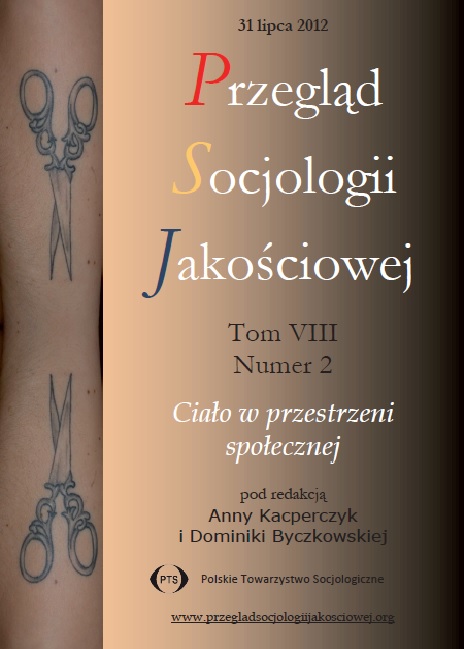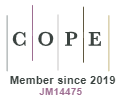Freak bodies (with)in a freak/talk show
DOI:
https://doi.org/10.18778/1733-8069.8.2.10Keywords:
freak, freak show, corporeal difference, representation of otherness, disabilityAbstract
The corporeal difference is the most fundamental in experiencing the otherness of the other. Confrontations with freak bodies in public spaces often leave us helpless, yet they call for strategies that would resolve the problem of their otherness. Modernity has formulated two basic rules governing the presence of heterotopic body: its medicalization and normativization. It would then seem that there is now a void where once was a freak show. Yet, the traces of freak shows’ spectacular logic can be traced in the television talk show formula. The comparison of these two is not aimed only at pointing at some superficial similarities, but also to more in-depth analogies concerning the logic of representation of corporeal otherness and lastly – to the metanarrative behind the show that justifies its obscenity. The paper concludes with a question of the possibility of adapting, yet, another strategy of making freak bodies publicly visible: freak show-based performances of disabled artists.
Downloads
References
Bauman Zygmunt (2000) Ponowoczesność jako źródło cierpień. Warszawa: Wydawnictwo Sic!
Google Scholar
Bogdan Robert (1996) The Social Construction of Freaks [w:] Rosemarie Garland-Thomson, ed., Freakery. Cultural Spectacles of the Extraordinary Body. New York: New York University Press, s. 23–37.
Google Scholar
Dijck van José (2002) Medical documentary: conjoined twins as medical spectacle. „Media, Culture & Society”, vol 24, no. 4, s. 537–556.
Google Scholar
DOI: https://doi.org/10.1177/016344370202400405
Durbach Nadja (2010) Spectacles of Deformity. Freak Shows and Modern British Culture. Berkeley: University of California Press.
Google Scholar
DOI: https://doi.org/10.1525/9780520944893
Garland-Thomson Rosemarie, ed., (1996) Freakery. Cultural Spectacles of the Extraordinary Body. New York: New York University Press.
Google Scholar
Garland-Thomson Rosemarie, ed., (2009) Staring. How We Look. New York: Oxford University Press.
Google Scholar
Godzic Wiesław (2004) Telewizja i jej gatunki po „Wielkim Bracie”. Kraków: Wydawnictwo Universitas.
Google Scholar
Goffman Erving (2005) Piętno. Rozważania o zranionej tożsamości. Przełożyły Aleksandra Dzierżyńska, Joanna Tokarska-Bakir. Gdańsk: Gdańskie Wydawnictwo Psychologiczne.
Google Scholar
Hadley Bree (2008) Mobilizing the Monster: Modern Disabled Performers’ Manipulation of the Freakshow. „M/C Journal”, vol. 11, no. 3 [dostęp 7 czerwca 2010 r.]. Dostępny w Internecie http://journal.mediaculture.org.au/index.php/mcjournal/article/viewArticle/47
Google Scholar
DOI: https://doi.org/10.5204/mcj.47
Kuppers Petra (2004) Disability and Contemporary Performance: Bodies on Edge. New York: Routledge.
Google Scholar
McKenzie Jon (1995) Telepathy, the Elephant Man, Monstration. „Journal of Popular Culture”, vol. 28, no. 4, s. 19–36.
Google Scholar
DOI: https://doi.org/10.1111/j.0022-3840.1995.00019.x
Rozmowy w toku. Prowadząca Ewa Drzyzga. Wybrane odcinki programu emitowanego przez TVN w latach 2007–2008 [dostęp 5 czerwca 2010 r.]. Dostępne w Internecie http://rozmowywtoku.tvn.pl/odcinki.html
Google Scholar
Sandahl Carrie, Auslander Philip, eds., (2005) Bodies in commotion: disability and performance. Ann Arbor: The University of Michigan Press.
Google Scholar
DOI: https://doi.org/10.3998/mpub.92455
Snyder Sharon L., Mitchell David T. (2001) Re-engaging the Body: Disability Studies and the Resistance to Embodiment. „Public Culture”, vol. 13, no. 3, s. 367–389.
Google Scholar
DOI: https://doi.org/10.1215/08992363-13-3-367
Stulman Dennett Andrea (1996) The Dime Museum Freak Show Reconfigured as Talk Show [w:] Rosemarie Garland-Thomson, ed., Freakery. Cultural Spectacles of the Extraordinary Body. New York: New York University Press, s. 315–326.
Google Scholar
Wieczorkiewicz Anna (2006a) Powrót Człowieka-Słonia. O problemach z doświadczaniem obcości [w:] Ryszard Nycz, Anna Zeidler-Janiszewska, red., Nowoczesność jako doświadczenie. Kraków: Wydawnictwo Universitas, s. 135–164.
Google Scholar
Wieczorkiewicz Anna (2006b) Osobny świat osobliwości. „Kultura i Społeczeństwo”, nr 4, s. 3–30.
Google Scholar
Downloads
Published
How to Cite
Issue
Section
License

This work is licensed under a Creative Commons Attribution-NonCommercial-NoDerivatives 4.0 International License.














